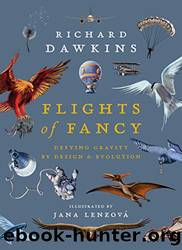Flights of Fancy: Defying Gravity by Design and Evolution by Dawkins Richard

Author:Dawkins, Richard [Dawkins, Richard]
Language: eng
Format: epub
Tags: Science, History
ISBN: 9781838937874
Amazon: B097F6X638
Goodreads: 114124441
Publisher: Apollo
Published: 2021-11-04T07:00:00+00:00
© Shutterstock. Contributor: Hand with card (Maisei Raman)
CHAPTER 8
POWERED FLIGHT IN ANIMALS
CHAPTER 8
POWERED FLIGHT IN ANIMALS
Animal flight is more complicated and difficult to understand than that of human machines. This is partly because flapping wings drive the animal forwards (the plane principle) at the same time as they thrust air downwards (more like a helicopter). If you watch a flying bird in a slow-motion film (you need slow motion to even hope to see what is going on) youâll notice that the wings are not simply flapping up and down. The curvature of the wings combined with the supple bendiness of the feathers propels the bird forwards, which in turn provides lift by the two methods we saw in Chapter 7, the Newtonian and Bernoullian methods. At the same time, the downstroke of the wings provides lift in its own right, as we saw at the beginning of Chapter 7, the helicopter part. The upstroke doesnât spoil things by having the reverse effect that we might naively expect. This is partly because of the curvature of the wing, and partly because it twists during the upstroke, and the elbow and wrist joints pull inwards so the area of the wing is reduced compared to the powerful downstroke.
Lacking propellers or jets, birds and other flying animals use their wings to propel themselves forwards as well as to provide lift directly. This is unlike man-made planes, whose wings provide lift but not forward propulsion. The opposite extreme, where wings are exclusively concerned with forward propulsion but not lift, can be seen in penguins, but thatâs underwater of course, rather than in air. Penguins are buoyant, lighter than water, so they donât need wings for lift. Instead, they use their wings for âflyingâ underwater. Unlike on land where they waddle with a slow, ungainly gait, penguins streak through the water extremely fast like dolphins, although dolphins propel themselves in a different way, using up and down movements of the tail. Both dolphins and penguins are beautifully streamlined. Streamlining would have come easily to the ancestors of penguins, already streamlined for flying through the air.
Download
This site does not store any files on its server. We only index and link to content provided by other sites. Please contact the content providers to delete copyright contents if any and email us, we'll remove relevant links or contents immediately.
| Amphibians | Animal Behavior & Communication |
| Animal Psychology | Ichthyology |
| Invertebrates | Mammals |
| Ornithology | Primatology |
| Reptiles |
Sapiens: A Brief History of Humankind by Yuval Noah Harari(14322)
The Tidewater Tales by John Barth(12627)
Mastermind: How to Think Like Sherlock Holmes by Maria Konnikova(7281)
Do No Harm Stories of Life, Death and Brain Surgery by Henry Marsh(6908)
The Thirst by Nesbo Jo(6882)
Why We Sleep: Unlocking the Power of Sleep and Dreams by Matthew Walker(6659)
Life 3.0: Being Human in the Age of Artificial Intelligence by Tegmark Max(5518)
Sapiens by Yuval Noah Harari(5325)
The Longevity Diet by Valter Longo(5044)
The Body: A Guide for Occupants by Bill Bryson(5032)
The Rules Do Not Apply by Ariel Levy(4912)
The Immortal Life of Henrietta Lacks by Rebecca Skloot(4552)
Animal Frequency by Melissa Alvarez(4430)
Why We Sleep by Matthew Walker(4395)
The Hacking of the American Mind by Robert H. Lustig(4342)
Yoga Anatomy by Kaminoff Leslie(4334)
All Creatures Great and Small by James Herriot(4273)
Double Down (Diary of a Wimpy Kid Book 11) by Jeff Kinney(4244)
Embedded Programming with Modern C++ Cookbook by Igor Viarheichyk(4143)
